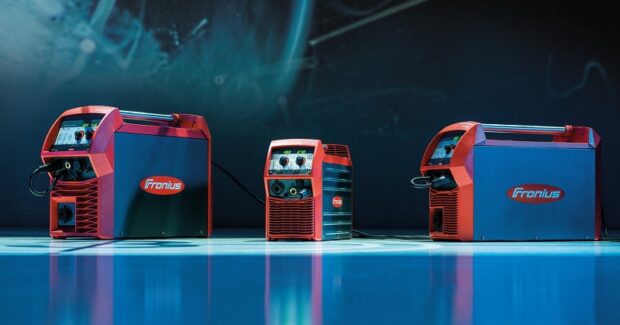Welding Systems Reduce Costs in High Volume Operations or Jobsite Work
The TPS/i TWIN Push tandem welding system from Fronius is ideal for high-volume precision, while their TransSteel Series multi-process welding systems provide high-quality flexibility do a wide variety of different tasks.
Posted: October 18, 2019
High-performance welding is characterized by a heavy deposition rate that permits a high weld-seam volume or fast welding speeds and is particularly important for joining high-volume components or long seams used in construction machinery, commercial vehicles, automotive parts and shipbuilding operations. New process and control options in the TPS/i TWIN Push PMC (Pulse Multi Control) system from Fronius USA LLC (Portage, IN) feature a short, focused pulsed arc for improved penetration and higher welding speed. The high processor power of the TPS/i improves the synchronized TWIN Push tandem process, making it even more stable and reliable, and enhanced gap-bridging ability saves the user time at the component preparation stage. The amount of rework can also be reduced because precise control of the welding process enables controlled droplet detachment and low heat input into the component, permitting low-spatter results with minimal distortion.
The PulseSync option allows the user to select widely varying travel speeds for the two wire electrodes to achieve greater flexibility, ideally adjusting the welding parameters to the component to attain higher welding speeds. The power source automatically corrects all relevant power source parameters, including ignition properties, the point of droplet detachment and the pulse ratio. New control mechanisms include an arc length stabilizer and a penetration stabilizer that increase process stability and make it easier to configure parameters. Automatic seam tracking corrects any variance of the position of the interface due to component distortion or imprecise clamping. During welding, the system transmits a seam tracking signal to the robot so that it can make corrections as required. The TWIN process is based on tandem welding and features two wire electrodes that are fed into a welding torch with a single gas nozzle but remain electrically isolated from one another. As a result, the arcs can be controlled independently and, despite differing outputs, can be precisely synchronized and coordinated.
In addition to two TPS/i power sources, the TWIN Push system requires a TWIN Controller that synchronizes the welding process and acts as an interface that is compatible with all robot brands. A compact wirefeeder, cooling system, hosepack and TWIN welding torch complete the welding system. The cooling system for the torch has been improved to extend the service life of wear parts. Alongside this, the Robacta TSS/i TorchServiceStation is a welding torch cleaning system that combines a number of cleaning methods, including high pressure cleaning, brush cleaning and magnetic cleaning, as well as cleaning by means of a cutter. This professional torch cleaning device lowers overall system costs by also extending the service life of wear parts. The efficiency of the welding system is further increased with the TX TWIN welding torch change station. Its console allows automatic switching between TWIN and Single torch bodies so that the same system can be used to weld areas that are particularly difficult to access with a more compact single-torch body. The robot automatically changes the torch body for unmanned shift operations.
When day-to-day welding involves a wide variety of different tasks, a multi-process device is key, whether manufacturing parts in a metalworking shop or repairing an agricultural vehicle. Alongside their existing TransSteel 2200 multi-process welding system, the new TransSteel 2700 and TransSteel 3500 Compact systems from Fronius provide increased power to carry out TIG, MIG/MAG and SMAW welding at equally high standards by combining a functional, compact machine design with simple operation and a fair price. The TransSteel 2200 delivers a maximum 220 amps, while the TransSteel 2700 provides up to 270 amps and the TransSteel 3500 C offers up to 350 amps, all with power sources that achieve maximum output during welding with no loss of power.
All of these machines are equipped with a polarity reverser that plugs into the front of the machine to weld flux-core wires using a negative pole. A second gas solenoid valve allows a variety of gas bottles to be connected. The device automatically detects which gas is required for each specific process, eliminating the need to switch between different gases manually. All three processes are found on the control panel so that switching between processes takes less than a minute. Accessing specific background menus is only required when setting up special functions and special welding parameters. TransSteel systems are ideal for beginners: The simplified process and setting options make it easy for anyone to use the systems, no matter what their skill level. The 3-in-1 solution also helps to minimize investment costs and running costs for wearing parts because one machine can do the work of three different welding systems.
Fronius USA LLC, 6797 Fronius Drive, Portage, IN 46368, 219-734 5701, [email protected], www.fronius.com/en/welding-technology.













